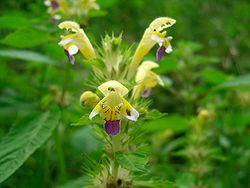Lamiales
| Lamiales Temporal range:
| |
|---|---|

| |
| Galeopsis speciosa | |
| Scientific classification | |
| Kingdom: | Plantae |
| Clade: | Tracheophytes |
| Clade: | Angiosperms |
| Clade: | Eudicots |
| Clade: | Asterids |
| Clade: | Lamiids |
| Order: | Lamiales Bromhead[2]
|
| Families[3] | |
| |
This article includes a list of general references, but it lacks sufficient corresponding inline citations. (May 2012) |
The Lamiales (also known as the mint order) are an
Description

A number of species of

Taxonomy
Phylogeny
The
| Lamiales |
| ||||||||||||||||||||||||||||||
The Lamiales previously had a restricted circumscription (e.g., by
Also, the circumscription of family
Dating
Much research has been conducted in recent years regarding the dating the Lamiales lineage, although there still remains some ambiguity. A 2004 study, on the molecular phylogenetic dating of asterid flowering plants, estimated 106 million years (MY) for the stem lineage of Lamiales.[13] A similar study in 2009 estimated 80 million years.[14] Another 2009 study gives several reasons why the issue is particularly difficult to solve.[6]
Habitat
The Lamiales order can be found in almost all kinds of habitats world-wide.
Uses
The order Lamiales has a variety of species with anthropogenic uses, the most popular belonging to the
Species within the order are also known to have properties to repel insects and help control harmful diseases from insects, such as Malaria from mosquitos.[17][16] Plants of the family Acanthaceae have bioactive secondary metabolites within their mature leaves, which have been found to be toxic to insect larvae.[17] Botanical derived insecticides are a good alternate for chemical or synthetic insecticides as it is inexpensive, abundant and safe for other plants, non-target organisms and the environment.[17]
Many species within the order are used as decorations,
References
- ^ M. E. J. Chandler. 1964. The Lower Tertiary Floras of Southern England. IV. A summary and survey of findings in the light of recent botanical observations.
- hdl:10654/18083.
- ^ .
- ^ .
- ISBN 978-0-19-883333-8.
- ^ PMID 21073690.
- ^ OCLC 53375899.
- ^ PMID 11163173.
- PMID 17652341.
- ^ PMID 32652014.
- PMID 21632432.
- PMID 21073690.
- PMID 15503676.
- PMID 21628193
- ^ PMID 34365014.
- ^ a b c d e f g Sharma, Archna; Sharma, Alka; Kumar, Vijay; Kumar, Ashwini (2015). "Selected Medicinal Plants of Order Lamiales Used in Traditional Medicine". American Journal of Pharmacy and Health Research. 3 (1) – via ResearchGate.
- ^ PMID 25222784.
- ^ a b Maxia, Andrea; Meli, Francesca; Gaviano, Carla; Picciau, Rosangela; De Martis, Bruno; Kasture, Sanjay; Kasture, Veene (2013). "Dye plants: Natural resources from traditional botanical knowledge of Sardinia Island, Italy". Indian Journal of Traditional Knowledge: 651–656.
External links
- Lamiales
- A parsimony analysis of the Asteridae sensu lato based on rbcL sequences
- Disintegration of the Scrophulariaceae Archived 2007-03-10 at the Wayback Machine (deals with relationships throughout Lamiales)
- L. Watson and M.J. Dallwitz (1992 onwards). The families of flowering plants: descriptions, illustrations, identification, information retrieval. http://delta-intkey.com
- Acanthaceae 2002-09-06
- https://web.archive.org/web/20070630151231/http://www.biologie.uni-hamburg.de/b-online/d52/52e.htm 2002-09-06
- https://web.archive.org/web/20070609093206/http://www.biologie.uni-hamburg.de/b-online/d52/52efam.htm 2002-09-06
- https://web.archive.org/web/20050914001131/http://www.science.siu.edu/parasitic-plants/Relation-Scroph.html
- https://web.archive.org/web/20070311032641/http://www.rbgkew.org.uk/web.dbs/genlist.html 2002-09-06
 Media related to Lamiales at Wikimedia Commons
Media related to Lamiales at Wikimedia Commons Data related to Lamiales at Wikispecies
Data related to Lamiales at Wikispecies
